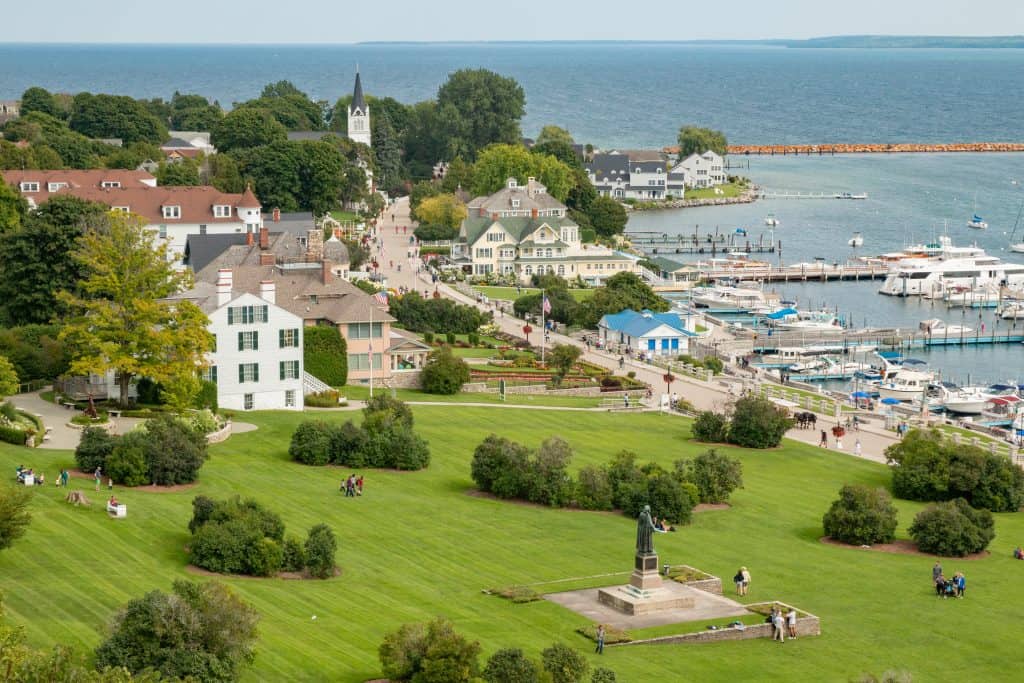Mackinac Island, a small island located in Michigan, is a popular tourist destination known for its historic charm and breathtaking beauty. However, despite its popularity and scenic beauty, Mackinac Island is not a United States National Park.
Criteria to Become A National Park
It is important to understand the criteria for a place to become a National Park. National Parks are designated by the NPS, the federal agency that manages and conserves over 84 million acres of land and water resources in the United States. To become a National Park, a place must be of national significance and have unique resources that require protection and preservation.
Additionally, the area must have adequate resources to support the management, administration, and protection of the park. This has actually been a barrier to entry for some potential national parks such as Bandalier National Monument in New Mexico. It lacks funding and intrastructure to support the additional tourism that national park status would draw.
Mackinac Island, however, does not lack in resources.
Mackinac Island: Our Second National Park
You may be surprised to know that Mackinac Island was actually the second National Park in the United States’ National Park Service (NPS) system! From 1875 until 1895, the Island was a national park managed by soldiers from Fort Mackinac. However, when the fort closed in 1895, it became clear that the park would be run most efficiently by the Michigan State Park System.
Mackinac Island is now successfully protected and managed by the State of Michigan. It is only 8.2 square miles and has a small population of around 500 residents.
The entire island is a state park which means it is protected by state laws and regulations. It is managed by the Michigan Department of Natural Resources. Additionally, the island has its own unique local government which ensures that its historic character and natural beauty are preserved and protected.

The Mackinac Experience
Despite not being a National Park, Mackinac Island still offers visitors a unique and breathtaking experience.
The island is home to historic Fort Mackinac, a 19th-century military fort that provides a glimpse into the island’s rich history. Due to the vast tourism that the island enjoys, there is frequent family programming through the summer season. From tours to exhibits to firing the famous cannon Fort Mackinac is a special place to learn and gather!
Visitors can also explore the island’s beautiful parks and nature trails. The eight mile hike around the perimeter of the island affords rare views in this idyllic setting. The forested Mackinac States Park offers additional hiking trails.
Back in town, visitors can explore the historic Grand Hotel, stop for some famous fudge, or take a horse-drawn carriage tour. Biking is another popular adventure on Mackinac.
Whatever travel adventures you prefer, you are likely to find them on our nation’s former second national park!
National Park Sites in Michigan
For visitors seeking a National Park experience, there are several alternatives available. Michigan is home to several National Parks, including Isle Royale National Park, Sleeping Bear Dunes National Lakeshore, and Keweenaw National Historical Park.
Isle Royale National Park
Isle Royale National Park is a remote wilderness area located in the northernmost part of Michigan. In fact, it is an island on Lake Superior!
The park is accessible only by boat or seaplane and covers over 850 square miles of pristine wilderness including forests, lakes, and streams. The park is known for its rugged and isolated beauty as well as its abundance of wildlife including wolves, moose, and otters.
Visitors to Isle Royale can hike, camp, fish, and explore the many lakes and rivers that make up the park. The park is also home to several historic lighthouses including the Rock Harbor Lighthouse which has been in operation since 1855.
Isle Royale is a popular destination for outdoor enthusiasts and nature lovers. It offers a unique and unforgettable wilderness experience for those willing to make the journey to this remote and beautiful place. For more information on how to access this wonderland, read Island Adventures: Exploring United States National Parks on Islands.
Pictured Rocks National Lakeshore
Pictured Rocks is a National Lakeshore located in the Upper Peninsula of Michigan. It is known for its beautiful cliffs that rise out of Lake Superior and display a variety of colors and patterns including streaks of red, green, black, and white.
These cliffs have been sculpted over time by wind, water, and ice, and they are truly a natural wonder to behold. Visitors to Pictured Rocks can take a boat tour or hike along the lakeshore to experience the beauty of the cliffs up close.
The area is also home to a variety of wildlife including bald eagles, black bears, and white-tailed deer. Pictured Rocks is a popular destination for outdoor enthusiasts, photographers, and nature lovers alike, and it is definitely worth a visit for anyone traveling to Michigan.
Sleeping Bear Dunes Naitonal Lakeshore
Sleeping Bear Dunes is a National Lakeshore located in the northwestern Lower Peninsula of Michigan. It is named after a legend that tells the story of a mother bear and her two cubs who swam across Lake Michigan and rested on the shoreline, forming the dunes.
The area is known for its towering sand dunes that rise over 400 feet above Lake Michigan offering stunning views of the water and the surrounding forests.
Visitors to Sleeping Bear Dunes can hike, swim, camp, and even go dune sledding down the steep slopes. The lakeshore is also home to a variety of wildlife including white-tailed deer, black bears, and coyotes.
Between the lakeshore, the dunes, and its charming gateway town, Traverse City, Sleeping Bear Dunes is a popular destination for outdoor enthusiasts, and is a must-visit for anyone traveling to Michigan!
Keweenaw National Historical Park
Keweenaw National Historic Park is located in Michigan’s Upper Peninsula and preserves the heritage and history of copper mining in the region. The park encompasses several historic mining sites including Quincy Mine which produced copper from the mid-1800s to the early 1900s.
Visitors to the park can take guided tours of the historic mine and learn about the dangerous and challenging work that miners faced during the boom years of copper mining. The park also includes a number of historic sites and museums that showcase the history and culture of the region including the Hanka Homestead Museum and the Delaware Copper Mine.
In addition to its rich history, the park is home to a diverse range of flora and fauna. There are opportunities for hiking, fishing, and other outdoor activities within this park.
Keweenaw National Historic Park is a special destination for history buffs and anyone else interested in Michigan’s industrial heritage.
The many Michigan NPS sites offer visitors a chance to explore the natural beauty and unique resources of the state, and they are managed and protected by the National Park Service.
Mackinac Island is not a National Park due to its limited size, limited resources, and its protection and management by the State of Michigan. However, the island still offers visitors a unique and breathtaking experience, and there are several National Parks available in Michigan for visitors seeking a National Park experience. Whether you are a history buff, nature lover, or simply seeking a peaceful getaway, Mackinac Island and Michigan’s National Parks have something to offer for everyone. Visit the Park Website for additional details.

